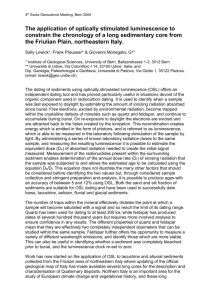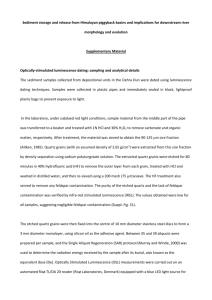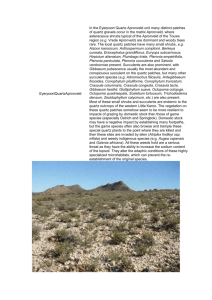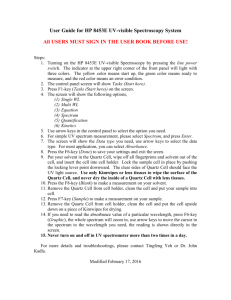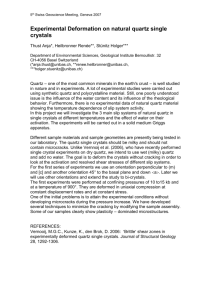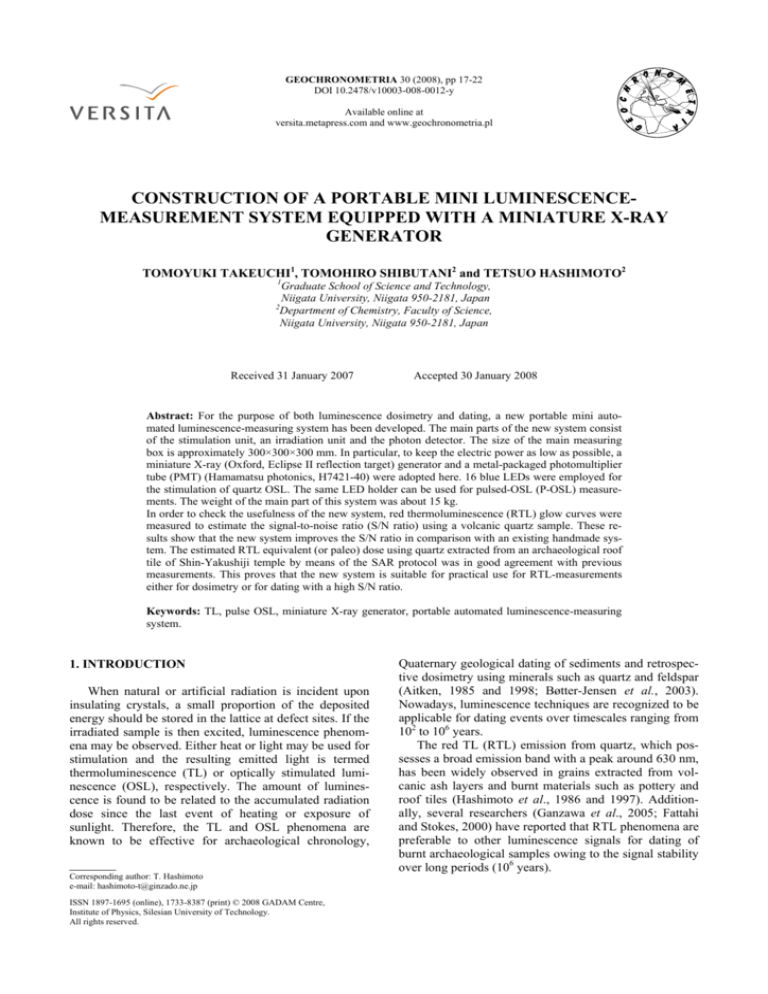
GEOCHRONOMETRIA 30 (2008), pp 17-22
DOI 10.2478/v10003-008-0012-y
Available online at
versita.metapress.com and www.geochronometria.pl
CONSTRUCTION OF A PORTABLE MINI LUMINESCENCEMEASUREMENT SYSTEM EQUIPPED WITH A MINIATURE X-RAY
GENERATOR
TOMOYUKI TAKEUCHI1, TOMOHIRO SHIBUTANI2 and TETSUO HASHIMOTO2
1
Graduate School of Science and Technology,
Niigata University, Niigata 950-2181, Japan
2
Department of Chemistry, Faculty of Science,
Niigata University, Niigata 950-2181, Japan
Received 31 January 2007
Accepted 30 January 2008
Abstract: For the purpose of both luminescence dosimetry and dating, a new portable mini automated luminescence-measuring system has been developed. The main parts of the new system consist
of the stimulation unit, an irradiation unit and the photon detector. The size of the main measuring
box is approximately 300×300×300 mm. In particular, to keep the electric power as low as possible, a
miniature X-ray (Oxford, Eclipse II reflection target) generator and a metal-packaged photomultiplier
tube (PMT) (Hamamatsu photonics, H7421-40) were adopted here. 16 blue LEDs were employed for
the stimulation of quartz OSL. The same LED holder can be used for pulsed-OSL (P-OSL) measurements. The weight of the main part of this system was about 15 kg.
In order to check the usefulness of the new system, red thermoluminescence (RTL) glow curves were
measured to estimate the signal-to-noise ratio (S/N ratio) using a volcanic quartz sample. These results show that the new system improves the S/N ratio in comparison with an existing handmade system. The estimated RTL equivalent (or paleo) dose using quartz extracted from an archaeological roof
tile of Shin-Yakushiji temple by means of the SAR protocol was in good agreement with previous
measurements. This proves that the new system is suitable for practical use for RTL-measurements
either for dosimetry or for dating with a high S/N ratio.
Keywords: TL, pulse OSL, miniature X-ray generator, portable automated luminescence-measuring
system.
1. INTRODUCTION
When natural or artificial radiation is incident upon
insulating crystals, a small proportion of the deposited
energy should be stored in the lattice at defect sites. If the
irradiated sample is then excited, luminescence phenomena may be observed. Either heat or light may be used for
stimulation and the resulting emitted light is termed
thermoluminescence (TL) or optically stimulated luminescence (OSL), respectively. The amount of luminescence is found to be related to the accumulated radiation
dose since the last event of heating or exposure of
sunlight. Therefore, the TL and OSL phenomena are
known to be effective for archaeological chronology,
Corresponding author: T. Hashimoto
e-mail: hashimoto-t@ginzado.ne.jp
ISSN 1897-1695 (online), 1733-8387 (print) © 2008 GADAM Centre,
Institute of Physics, Silesian University of Technology.
All rights reserved.
Quaternary geological dating of sediments and retrospective dosimetry using minerals such as quartz and feldspar
(Aitken, 1985 and 1998; Bøtter-Jensen et al., 2003).
Nowadays, luminescence techniques are recognized to be
applicable for dating events over timescales ranging from
102 to 106 years.
The red TL (RTL) emission from quartz, which possesses a broad emission band with a peak around 630 nm,
has been widely observed in grains extracted from volcanic ash layers and burnt materials such as pottery and
roof tiles (Hashimoto et al., 1986 and 1997). Additionally, several researchers (Ganzawa et al., 2005; Fattahi
and Stokes, 2000) have reported that RTL phenomena are
preferable to other luminescence signals for dating of
burnt archaeological samples owing to the signal stability
over long periods (106 years).
CONSTRUCTION OF A PORTABLE MINI LUMINESCENCE-MEASUREMENT SYSTEM EQUIPPED WITH…
for long term illumination for continuous-wave OSL
(CW-OSL) measurements. Each feature is described in
the following section. Tentatively, it was realized that the
total electrical power required is less than 50 W, except
for the PC and the heater which required an additional
128 W. The main measuring box size is approximately
300×300×300 mm.
Previously, in the author’s laboratory, an automated
luminescence-measuring system installed with a small
X-ray generator (Varian, VF-50) was constructed (Hashimoto et al., 2002; Nakagawa et al., 2003). However, that
luminescence-measurement system is too heavy to carry
and requires a large electric power supply over 500 W.
Therefore, the use of this system is limited to the dark
room of the experimental laboratory associated with large
electric power. A portable luminescence-measurement
system is useful for field work and as an educational tool
and similar. A trial of a portable OSL-measurement system without an irradiation facility has previously been
reported by Poolton et al. (1994), but this system too was
rather heavy. Here we describe the development of a
portable mini automated luminescence-measuring system,
which decreases both the size and the weight of the electrical system as well as the electronic power required. In
addition, the new system was designed to be able to make
pulsed-OSL (P-OSL) measurements in addition to the
RTL measurements. This paper describes features of a
newly portable mini automated luminescencemeasurement system, and presents the results of some
performance tests for RTL and P-OSL measurements
using the system.
The miniature X-ray generator
A miniature X-ray generator (Oxford, Eclipse-IIReflection) was employed as an irradiation source. This
X-ray generator was of reflection type, so the irradiation
facility should be installed at an angle of 28° as seen in
Fig. 1. The total weight of this generator amounts to
330 g, equivalent to about one third of the weight of the
X-ray system used previously (Varian, VF-50J) (Yawata
and Hashimoto, 2004).
In this new generator, the maximum anode current
and voltage are 0.1 mA and 30 kV, respectively, giving a
maximum electrical power requirement of 3 W. Since the
average X-ray energies from this X-ray generator are
about 9 kV, the half-thickness layer value of Al is calculated to be about 0.1 mm from the mass-attenuation coefficients of X-ray. Thus, Al plate of 0.1 mm thickness
should be sufficient for shielding of low-energy X-rays
from this generator enabling the miniaturization of the
system. However, for the current model the box was
made from steel for convenience. Furthermore, the use of
a fullerene as a cathode material in the X-ray tube, gives
the possibility of long-term life for the generator.
Since the X-rays arise from collision of the accelerated electrons with the rhodium (Rh) target, the energy
spectrum of the X-ray consists mainly of Bremsstrahlung
radiation, accompanied with a line spectrum or specific
X-ray at about 6 keV. The low energy X-rays at 6 keV
are too weak to pass though the full diameter of coarse
grains due to their short range within quartz (halfthickness layer value for quartz: 22 µm), so that inhomogeneous ionization will occur in the case of a coarse
quartz grain. Therefore, to ensure good reproducibility of
the dose rate, the X-ray beam was hardened by inserting
an Al absorber of 24 µm thickness between the X-ray
generator and the sample pan.
The dose-rate can be adjusted by changing the applied
voltage and/or the current because the X-ray strength is
proportional to the anode current and the applied voltage.
In Fig. 2, there exists a good linear relationship between
current and dose-rate at current beyond 10 µA. As a result, X-ray dose-rates are obtained over the range
1.3-6.8 Gy/min by varying the anode current from
10-50 µA under a fixed anode voltage of 30 kV as tube
potential.
2. SYSTEM DESIGN
Fig. 1 shows a conceptual view of the portable automated mini luminescence-measuring system. A computer
controls the system and can be used for the single-aliquot
regenerative-dose (SAR) protocol (Murray and Wintle,
2000). The main part of the new system consists of the
stimulation unit (a LED holder and heater assembly), an
irradiation unit and the luminescence detection system.
To minimize the electrical power requirements so that it
could in theory be powered by a small battery, a miniature X-ray generator and a metal-packaged PMT were
adopted for the new system. The LED holder has 16 blue
LEDs (Nichia Chemical Industries Ltd., NSPB-500S) and
16 infrared LEDs (Hamamatsu Photonics, L2690-02).
These diodes have peak emission at 470 nm and 890 nm,
respectively, with 50 nm FWHM value. Eight sample
pans on a rotation wheel can be measured in one cycle.
The control electronics allow the LEDs to be repeatedly
pulsed for pulsed-OSL (P-OSL) measurements, as well as
X-ray controller box
(Eclipse II;Oxford)
Photon-counting board
installed a computer
Mini X-ray generator
(Eclipse II;Oxford)
M etal-packaged
PM T
(HAMAMATSU, H7421)
Shutter
The metal-packaged PMT and heater assembly
The metal-packaged PMT (Hamamatsu photonics,
H7421-40) with a GaAsP photocathode surface offers a
response from the UV (300 nm) to the far-red (720 nm)
region, which is particularly suitable for the detection of
wide ranges for visible light regions, including red luminescence. Even when no light is incident on the photocathode, a small dark current can arise owing to thermo-
Light guide
Computer
LED holder
Rotation wheel
Ceramics heater
Heater temperature controller
Fig. 1. Conceptual view of the portable mini automated luminescencemeasuring system.
18
T. Takeuchi et al.
The total size of the PMT, including the Peltierdevice, of the air-cooling system is 104×76×56 mm
which is smaller than the existing photon counting box in
our laboratory.
Dose rate (Gy min-1)
10
The LED holder
Sixteen blue LEDs and 16 infra-red (IR) LEDs were
employed for stimulation of quartz OSL and stimulation
of feldspar IRSL, respectively. Only quartz OSL measurements will be described here. A DUG11 (Schøtt) filter
(detection region; 300-400 nm) was placed in front of the
PMT for OSL measurements. Two sheets of SC42 (FUJI
PHOTO FILM Co. Ltd.) plastic filters were placed in
front of each blue LED in order to remove the troublesome tail of blue light (<400 nm), which can cause high
background due to the overlap between detection window
and stimulation light wavelength.
The same LED holder can be used for both pulsedOSL (P-OSL) measurements as well as for continuous
wave OSL (CW-OSL) measurements. For the P-OSL
measurement, the following pulse widths and an interval
time can be adjusted, pulse widths may be 2, 4, 8 or 10 µs
and the time interval between pulses is 200-1600 µs.
In the case of P-OSL, the luminescence photon counting rate after pulsed stimulation should be accumulated as
a function of time over periods of many micro-seconds.
The blue LEDs were used to provide pulses 10 µs long
and the P-OSL signal was measured during the subsequent 200 microsecond intervals (see Fig. 6). For the sake
of such rapid pulse procedures, a fast pulse counter and
on-line display system has also been employed (Yawata
et al., 2006). In this system, LED trigger pulses at the
ending of LED light off and luminescence pulses are fed
to an ordinal 32bit PCI board (Z-cosmos, ZH-HTS2).
This PCI board consists of timing control IC and counting IC. All trigger and luminescence pulse occurring time
data were stored to fast in fast out (FIFO) RAM, followed
by transfer into CPU RAM providing 1 µs resolution
time. An accumulated P-OSL decay curve from every
repeated stimulation and luminescence measurement
were displayed on CRT in real-time. Finally, the P-OSL
data can be obtained either in an Excel form or text format.
1
WithoutAl absorber
WithAl absorber (24 m)
0.1
1
10
Anode current (µA)
100
Fig. 2. Plot of the dose rate as a function of the anode current. RTLquartz samples from volcanic origin were used for the measurements.
The dose standardization of these curves was carried out using the
same quartz grains irradiated to 5 and 10 Gy with a standard 137Cs
source.
ionic emission as noise. This noise should be reduced as
much as possible by cooling the PMT. For this purpose,
the PMT was cooled with a Peltier-device connected to
the metal-packaged PMT. This cooling device required
electric power of 7 W, keeping the PMT at 0°C when
operating the system at room temperature. The average
background level falls to about 170 cps when cooled,
compared with a rate of >3000 cps without cooling.
To reduce the background counts due to the blackbody radiation, the area of the heater top was designed to
be as small as possible, and stray-light produced from the
heater was excluded as much as possible. For this purpose, four ceramics heaters were encapsulated into a
brass frame giving a rod of 5 mm diameter and 5 mm
length. These ceramic heaters are commercially available
for soldering semiconductor circuits (size of one heater;
1.2×7×75 mm) and require 32 W (100 V) at maximum
heating. Since the heating part is limited only to the top
part, black-body radiation could be significantly reduced
in comparison with the normal large Nichrome-heater
plate. When a sample pan is conveyed under the photondetection part by the carousel, the sample pan on this
heater rod is lifted to avoid direct heat contact between
the sample pan and the carousel, followed by heating
start. Since the sample pan has a biotite brim, the area
exposed for photon-detection is restricted only to the
inner part of the sample vessel, as mentioned in a preceding paper (Yawata and Hashimoto, 2007). Thus, the total
electric power of heater part needs 128 W at maximum
and the highest temperature can be linearly realized up to
600°C.
Since the sensitive surface (diameter 5 mm) of the
PMT is small and it is situated at a relatively long distance from the luminescence sample, only poor detection
efficiency was obtainable for luminescence measurement.
To improve this situation, the poor light collection was
overcome using a clad-rod type glass light guide (Nissei
Denki Co. Ltd.), which was fixed between the luminescent sample and the PMT.
3. PERFORMANCE TESTS
Sample preparation
In the experiment, two kinds of quartz samples were
used. One was extracted from an ancient roof-tile (ShinYakushiji temple, Nara, Japan, built in A.D. 747.). The
equivalent dose of this quartz sample has previously been
estimated using another handmade system (Nakata et al.,
2007). Another sample was extracted from a volcanic ash
layer (Medeshima layer, Miyagi, Japan). The quartz extraction procedure is described briefly here. All extraction
procedures were carried out under faint red light to avoid
any influence of light-bleaching effects on the naturally
accumulated signals in quartz. The samples were gently
crushed into suitable sizes in an agate mortar and washed
with distilled water, 6M HCl and NaOH for 1 hour and
then treated with concentrated HF for 30 minutes under
19
CONSTRUCTION OF A PORTABLE MINI LUMINESCENCE-MEASUREMENT SYSTEM EQUIPPED WITH…
was used between the heater head and the inlet of the
light-guide. In addition, selection of the optimal optical
filter combinations was made. In the tests, the same
quartz sample and the same detection filter assembly
were employed for both measurement systems.
The RTL signals, background values and S/N ratios of
each system are summarized in Table 1. Table 1 shows
that the new system gives a higher S/N ratio for RTL
signals in comparison with the existing handmade one.
This means that the new system also could eliminate the
thermal background counts more effectively than the
existing handmade one, as seen Fig. 3 and Table 1. The
new system has a lower thermal background (1.9×104
counts, Fig. 3a) than the older system (2.5×104 counts,
Fig. 3b), resulting in a prominent peak in RTL at about
320°C. This reduction is because light leakage from the
heater was eliminated in the new system.
The high RTL measurement performance of the new
system may be due to the high sensitivity of the metalpackaged PMT in the red-region relative to the PMT with
a multi-alkaline surface used in the older system in spite
of the same optical filter combinations.
an ultrasonic agitator at 50°C. The remaining material
was subjected to density separation (2.63-2.67 g/cm3)
using sodium polytungstate solutions to purify the quartz
fraction. The quartz samples were sieved to select grains
of 75-150 µm diameters. The volcanic quartz sample was
heated at 450°C for 5 minutes to erase the naturally accumulated dose.
Comparison between the new system and the existing
system
In order to check the usefulness of the new system for
RTL measurement, RTL glow curve measurements were
carried out for the estimation of the signal-to-noise ratio
(S/N ratio) using a volcanic quartz sample, which was
irradiated with a fixed dose of 50 Gy. In this test, a combination of an R-60 (Toshiba) and an IRC-65L (Kenko)
filter, giving a detection region from 600-700 nm, were
employed. The preheat condition and heating rate were
220°C for 5 min and 1°C/s, respectively. The samples
were initially subjected to first glow curve measurement,
followed by a background-curve mainly due to blackbody radiation. The background-curve was subtracted
from the first glow curve. The remaining curve is called
the “RTL glow curve”. A RTL glow curve peak of quartz
appeared at about 320°C as seen in Fig. 3. Both the RTL
glow curve and the background-curve were integrated
over the range 310-330°C, which are called the “RTL
signal” and the “Background”, respectively. Identical
measurements, using the same detection filters, were
carried out using the present equipment and by the older
systems described by Nakagawa et al. (2003).
As it is well known, RTL measurements with low
background level are difficult because of the appearance
of black-body radiation which starts to appear beyond
250°C. To reduce the background to as low as level as
possible when measuring the red emission, the area of the
ceramics heater was minimized and tight light-shielding
Equivalent dose evaluation from burnt archaeological
roof-tile
In both TL colour image (TLCI) and TL-spectrometry
(Hashimoto et al. 1986, 1997), quartz samples from roof
tiles showed red-TL emissions. For estimation of the
RTL equivalent dose, the single-aliquot regenerative-dose
(SAR) protocol was adopted using special software developed for this system. In RTL measurements, the samples were heated from 50-400°C at a heating rate of 1°C/s
with a preheat temperature at 240°C for 5 minutes. The
applied X-ray dose-rate was 1.35 Gy/min when the X-ray
tube voltage and current were 30 kV and 15 µA, respectively.
The RTL signals were integrated in the plateau range
(320-340°C), which are decided from the plateau test of
TL glow curves derived from induced and natural RTL as
shown in Fig. 4a and b. The RTL intensities after correction of RTL sensitivity changes, when applying a test
dose of 1.35 Gy between the measurements, are plotted
against the regenerative doses to construct a dose response curve as seen in Fig. 5. The equivalent dose could
be estimated by interpolating the integrated natural RTL
(NTL) intensity onto the dose-response curve. In these
measurements, it was found from a test dose measurement that no sensitivity change occurred between each
measurement of the natural or a regenerated dose.
The naturally accumulated dose in three aliquots was
estimated to be 4.44±0.36 Gy, which agreed well with the
RTL intensity (counts x 104)
(a)
10.0
8.0
6.0
1
1. RTL + background
2. RTL
3. Background
2
4.0
2.0
0
220
3
240
260
280
300
320
340
360
oC
Temperature
Temperature / (°C)
RTL intensity (counts x 104)
(b)
4.0
3.0
1. RTL + background
2. RTL
3. Background
1
2
Table 1. Comparison between the new system and the existing handmade one. These results were obtained from one measurement as
shown in Fig. 3. The reproducibility of each glow curve was also
ensured.
2.0
3
1.0
0
220
240
260
280
300
320
340
360
Temperature
Temperature (°C)
/ oC
Fig. 3. Comparison of RTL measurements between (a) the new system described in the paper and (b) the existing handmade system.
New mini system
Handmade system
20
Background
RTL signal
(counts × 104) (counts × 104)
21.8
1.9
7.6
2.5
S/N ratio
11.4
3.0
T. Takeuchi et al.
ated by γ-ray of 137Cs with 150 Gy. The time-resolved
curve shown in Fig. 6 consists of the integrated signal
from 1.0×105 light pulse exposures and photon-detection
interval repetitions, which corresponds to the equivalent
of a 1 s CW-OSL illumination. From the decay-behaviour
analysis, the mean decay lifetime of this quartz sample
was evaluated to be 40.5±1.9 µs. This lifetime value
agrees with about 35 µs, which was evaluated by
Chithambo and Galloway (2000) for other quartz samples
by a similar P-OSL method and 40 µs as found by Denby
et al. (2006). Accordingly, this decay signal could be
attributed to the afterglow of the quartz sample.
previous results (4.4~5.11 Gy, dependent on the portion
of roof tile) using the handmade system (Nakata et al.,
2007). The experimental error on the equivalent dose is
derived from the standard deviation on the three aliquots
analyzed. From this result, this system has been confirmed to be suitable for RTL measurement with high
detection efficiency with a high experimental reproducibility.
Preliminary pulsed OSL measurement
An aliquot of volcanic quartz was used to demonstrate
the measurement of pulsed OSL. After preheating for
5 min. at 220°C, the sample temperature was kept at
125°C during blue-light pulsed stimulation, and the emitted signal was recorded with a resolution of 1 µs. The
applied stimulation photon pulse width is fixed to 10 µs
and the phosphorescence detection period (or interval
measuring time) is kept at 200 µs. Fig. 6 shows a typical
time-resolved curve for the volcanic quartz sample irradi1.
2.
3.
4.
5.
(a)
2.0
Plateau level
1
1.5
4. CONCLUSIONS
We successfully constructed a portable mini automated luminescence-measuring system fitted with a
miniature X-ray generator and metal-packaged PMT. The
new system is readily movable and greatly decreases the
electric power consumption compared with the existing
system. The volume of the main box is small, approximately 300×300×300 mm, excluding another box (about
230×130×350 mm) containing the heater controller and
X-ray controller. An outstanding problem is the additional electric power required for the ceramic heater
(128 W at maximum), but a gas-burner heater system
combined with a small gas-reservoir may be available in
the future and provide a potential solution.
Compared with the existing system, the new system
improves the signal to noise ratio for RTL while offering
smaller size and weight (about 15 kg instead of 35 kg in
the older system) of the main steel box, including the
X-ray irradiator and photon-detection system. This makes
the system portable, so that it could be used at archaeological sites and in classrooms. Moreover, P-OSL is also
confirmed to be possible to use in the new system.
In the RTL dose evaluation from a burnt archaeological roof-tile, the naturally accumulated dose from the new
system was in good agreement with previous results (Nakata et al., 2007). This means that the new system is
useful for practical measurements of RTL-signals either
for dosimetry or dating purposes with a high signal-tonoise ratio.
5.4 Gy
4.7 Gy
Natural
2.7 Gy
1.4 Gy
2
3
1.0
4
0.5
5
0
310
320
330
340
Temperature (°C)
RTL intensity (×104 counts)
(b)
350
360
2.5
1.
2.
3.
4.
5.
2.0
1.5
5.4 Gy
4.7 Gy
Natural
2.7 Gy
1.4 Gy
1
2
3
1.0
4
0.5
5
0
200
250
300
350
Temperature (°C)
400
Fig. 4. Changes of RTL glow curves (a) and plateau tests (b) for quartz
grains extracted from the roof tile of the Shin-Yakushiji temple.
ACKNOWLEDGEMENTS
3.0
P-OSL counts (×103 counts)
RTL signal (×105 counts)
The authors would like to express their appreciation
natural data (NTL)
corrected data
2.0
1.0
0
0
1.0
2.0
3.0
4.0
Regenerative
dose (Gy)
Regenerative dose/
Gy
5.0
Paleo dose
2.5
2.0
1.5
1.0
0.5
0.0
0 10
Fig. 5. RTL dose response curve from a sample of the roof tile of the
Shin-Yakushiji temple. RTL sensitivity changes between the measurements were corrected on the basis of luminescence intensities when
applying the test dose of 1.35 Gy.
50
100
Time (µs)
150
200
Fig. 6. Time resolved response of quartz under pulsed stimulation. The
results have been integrated for 1.0×105 pulse repetitions, which
corresponds to a total of 1 s CW-OSL illumination.
21
CONSTRUCTION OF A PORTABLE MINI LUMINESCENCE-MEASUREMENT SYSTEM EQUIPPED WITH…
Hashimoto T, Koyanagi A, Yokosaka K, Hayashi Y and Sotobayashi T,
1986. Thermoluminescence color images from quartzes of beach
sands. Geochemical Journal 20: 111-118.
Hashimoto T, Sugai N, Sakaue H, Yasuda K, and Shirai N, 1997. Thermoluminescence (TL) spectra from quartz grains using on-line TL
spectrometric system. Geochemical Journal 31: 189-201.
Hashimoto T, Nakagawa T, Hong DG, and Takano M, 2002. An automated system for both red/blue thermoluminescence and optically
stimulated luminescence measurement. Journal of Nuclear Science
and Technology 39(1): 108-109, DOI 10.3327/jnst.39.108.
Murray AS and Wintle AG, 2000, Luminescence dating of quartz using
an improved single-aliquot regenerative-dose protocol. Radiation
Measurements 32(1): 57-73, DOI 10.1016/S1350-4487(99)00253X.
Nakagawa T, Usuda H and Hashimoto T, 2003. Optically stimulated
luminescence (OSL) and thermoluminescence (TL) measurements
on red TL (RTL) quartz samples using a new automated OSL/TL
measuring system. Journal of Radioanalytical and Nuclear Chemistry 255(2): 355-358, DOI 10.1023/A:1022517123226.
Nakata Y, Tamaki M, and Hashimoto T, 2007. Redthermoluminescence dating using quartz grains extracted from a
roof-tile of an old Japanese temple. Journal of Radioanalytical and
Nuclear Chemistry 272(2): 433-438, DOI 10.1007/s10967-0070542-1.
Poolton NRJ, Bøtter-Jensen L, Wintle AG, Jakobsen F and Knudsen
KL, 1994. A portable system for the measurement of sediment
OSL in the field. Radiation Measurements 23(2-3): 529-532, DOI
10.1016/1350-4487(94)90093-0.
Yawata T and Hashimoto T, 2004. Availability of a small X-ray tube
combined with Al-absorber as a new irradiator for luminescence
researches. Radioisotopes 53: 207-212.
Yawata T, Sakaue H, Itou S and Hashimoto T, 2006. Usability of a new
multiple high speed pulse time data registration, processing and
realtime display system for pulse time interval analysis. Transactions of the Atomic Energy society of Japan 5: 221-228 (in Japanese).
Yawata T and Hashimoto T, 2007. Development of a TL detection
system for a single grain of quartz. Radiation Measurements 42(9):
1460-1468, DOI 10.1016/j.radmeas.2007.03.008.
to Mr. S. Itou, Z-cosmos Co. Ltd., for providing valuable
information related to data-processing and electronics for
the present measurement system.
We would like to thank Professor G.A.T. Duller, University of Wales, Aberystwyth, for his valuable comments and kind corrections of our manuscript. The present work was supported greatly by Grant-in Aids for
Fundamental Science Research from Ministry of Education, Culture, Sports, Science and Technology, Japan (no.
17500691).
REFERENCES
Aitken MJ, 1985. Thermoluminescence Dating. London, Academic
Press: 359 pp.
Aitken MJ, 1998. An Introduction to Optical Dating. The Dating of
Quaternary Sediments by the Use of Photon-stimulated Luminescence. Oxford, Oxford University Press: 267pp.
Bøtter-Jensen L, McKeever SWS, and Wintle AG, 2003. Optically
Stimulated Luminescence Dosimetry. Amsterdam, Elsevier: 355pp.
Chithambo ML and Galloway RB, 2000. On luminescence lifetime in
quartz. Radiation Measurements 32(5-6): 621-626, DOI
10.1016/S1350-4487(00)00096-2.
Denby PM, Bøtter-Jensen L, Murray AS, Thomsen KJ, and Moska P,
2006. Application of pulsed OSL to the separation of the luminescence components from a mixed quartz/feldspar sample. Radiation
Measurements
41(7-8):
774-779,
DOI
10.1016/j.radmeas.2006.05.017.
Fattahi M and Stokes S, 2000. Red thermoluminescence (RTL) in
volcanic quartz: development of a high sensitivity detection system and some preliminary findings. Ancient TL 18(2): 35-44.
Ganzawa Y, Frukawa H, Hashimoto T, Sanzelle S, Mialliere D and
Pillevre J, 2005. Single grains dating of volcanic quartz from pyroclastic flows using Red TL. Radiation Measurements 39(5): 479487, DOI 10.1016/j.radmeas.2004.10.012.
22


